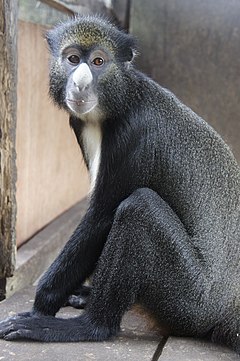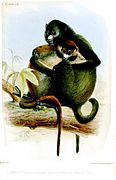Cercopithecus nictitans
Hocheur, Cercopithèque hocheur

NT : Quasi menacé
Statut CITES
Le hocheur ou cercopithèque hocheur (Cercopithecus nictitans) est une espèce de mammifères primates de la famille des Cercopithécidés, qui fait partie des singes africains de cette famille couramment appelés « pains à cacheter » ou « blancs-nez » en raison d'une tache blanche très claire et caractéristique sur leur nez.
Dénominations
[modifier | modifier le code]- Nom scientifique valide : Cercopithecus nictitans (Linnaeus, 1766)[1]
- Noms vulgaires (vulgarisation scientifique) recommandés ou typiques en français : Hocheur[2],[3],[4] ou Cercopithèque hocheur[3],[4].
- Autres noms vulgaires ou noms vernaculaires (langage courant) pouvant désigner éventuellement d'autres espèces : Hocheur blanc-nez[5],[4], même si ce nom semble plutôt désigner l'espèce Cercopithecus petaurista, blanc-nez[6] ou pain à cacheter[6],[4].
Description
[modifier | modifier le code]-
Planche zoologique de 1849
-
Un adulte de la sous-espèce Cercopithecus nictitans martini
-
Un jeune individu vu de face
Liste des sous-espèces
[modifier | modifier le code]Selon Mammal Species of the World (version 3, 2005) (16 juillet 2014)[7] :
- sous-espèce Cercopithecus nictitans nictitans
- sous-espèce Cercopithecus nictitans martini
Répartition et habitat
[modifier | modifier le code]
Cette espèce est présente au Liberia, en Côte d'Ivoire, au Nigeria, au Cameroun, en Guinée équatoriale, en République centrafricaine, au Gabon, en République du Congo et en République démocratique du Congo. Elle vit dans la forêt tropicale humide de plaine et de montagne[8].
Comportement
[modifier | modifier le code]Cette espèce est sociale et vit en groupe de 12 à 30 individus[9].
Alimentation
[modifier | modifier le code]Il est frugivore et granivore. Il complète son alimentation avec des feuilles et des insectes[9].
Reproduction
[modifier | modifier le code]Cercopithecus nictitans est polygame, un mâle vit avec plusieurs femelles et leurs petits. La femelle atteint sa maturité sexuelle à 4 ans environ. La gestation dure 172 jours en moyenne[9].
Notes et références
[modifier | modifier le code]- Integrated Taxonomic Information System (ITIS), www.itis.gov, CC0 https://doi.org/10.5066/F7KH0KBK, consulté le 20 juin 2019
- Meyer C., ed. sc., 2015, Dictionnaire des Sciences Animales. [lire en ligne]. Montpellier, France, Cirad.
- UICN, consulté le 20 juin 2019
- (en) Murray Wrobel, Elsevier's Dictionary of Mammals : in Latin, English, German, French and Italian, Amsterdam, Elsevier, , 857 p. (ISBN 978-0-444-51877-4, lire en ligne)
- (en) Murray Wrobel, Elsevier's Dictionary of Mammals : in Latin, English, German, French and Italian, Amsterdam, Elsevier, , 857 p. (ISBN 978-0-444-51877-4, lire en ligne), entrée N°1057.
- Blancs-nez dans Meyer C., ed. sc., 2015, Dictionnaire des Sciences Animales. Montpellier, France, Cirad.
- Mammal Species of the World (version 3, 2005), consulté le 16 juillet 2014
- (en) Référence UICN : espèce Cercopithecus nictitans (Linnaeus, 1766) (consulté le )
- (en) Référence Animal Diversity Web : Cercopithecus nictitans
Liens externes
[modifier | modifier le code]- (en) Référence Mammal Species of the World (3e éd., 2005) : Cercopithecus nictitans
- (en) Référence Brainmuseum : Cercopithecus nictitans
- (fr) Référence CITES : taxon Cercopithecus nictitans (sur le site du ministère français de l'Écologie) (consulté le )
- (fr + en) Référence ITIS : Cercopithecus nictitans (Linnaeus, 1766)
- (en) Référence Animal Diversity Web : Cercopithecus nictitans
- (en) Référence NCBI : Cercopithecus nictitans (taxons inclus)
- (en) Référence UICN : espèce Cercopithecus nictitans (Linnaeus, 1766) (consulté le )
- (en) Référence CITES : espèce Cercopithecus nictitans (Linnaeus, 1766) (+ répartition sur Species+) (consulté le )
Text is available under the CC BY-SA 4.0 license; additional terms may apply.
Images, videos and audio are available under their respective licenses.




